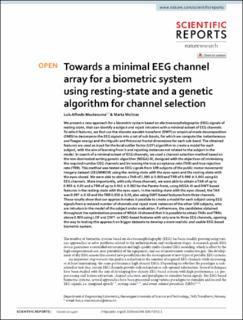| dc.contributor.author | Moctezuma, Luis Alfredo | |
| dc.contributor.author | Molinas Cabrera, Maria Marta | |
| dc.date.accessioned | 2020-09-29T11:20:08Z | |
| dc.date.available | 2020-09-29T11:20:08Z | |
| dc.date.created | 2020-09-12T20:20:23Z | |
| dc.date.issued | 2020 | |
| dc.identifier.issn | 2045-2322 | |
| dc.identifier.uri | https://hdl.handle.net/11250/2680265 | |
| dc.description.abstract | We present a new approach for a biometric system based on electroencephalographic (EEG) signals of resting-state, that can identify a subject and reject intruders with a minimal subset of EEG channels. To select features, we first use the discrete wavelet transform (DWT) or empirical mode decomposition (EMD) to decompose the EEG signals into a set of sub-bands, for which we compute the instantaneous and Teager energy and the Higuchi and Petrosian fractal dimensions for each sub-band. The obtained features are used as input for the local outlier factor (LOF) algorithm to create a model for each subject, with the aim of learning from it and rejecting instances not related to the subject in the model. In search of a minimal subset of EEG channels, we used a channel-selection method based on the non-dominated sorting genetic algorithm (NSGA)-III, designed with the objectives of minimizing the required number EEG channels and increasing the true acceptance rate (TAR) and true rejection rate (TRR). This method was tested on EEG signals from 109 subjects of the public motor movement/imagery dataset (EEGMMIDB) using the resting-state with the eyes-open and the resting-state with the eyes-closed. We were able to obtain a TAR of 1.000±0.000 and TRR of 0.998±0.001 using 64 EEG channels. More importantly, with only three channels, we were able to obtain a TAR of up to 0.993±0.01 and a TRR of up to 0.941±0.002 for the Pareto-front, using NSGA-III and DWT-based features in the resting-state with the eyes-open. In the resting-state with the eyes-closed, the TAR was 0.997±0.02 and the TRR 0.950±0.05, also using DWT-based features from three channels. These results show that our approach makes it possible to create a model for each subject using EEG signals from a reduced number of channels and reject most instances of the other 108 subjects, who are intruders in the model of the subject under evaluation. Furthermore, the candidates obtained throughout the optimization process of NSGA-III showed that it is possible to obtain TARs and TRRs above 0.900 using LOF and DWT- or EMD-based features with only one to three EEG channels, opening the way to testing this approach on bigger datasets to develop a more realistic and usable EEG-based biometric system. | en_US |
| dc.language.iso | eng | en_US |
| dc.publisher | Nature Research | en_US |
| dc.relation.uri | https://www.nature.com/articles/s41598-020-72051-1 | |
| dc.rights | Navngivelse 4.0 Internasjonal | * |
| dc.rights.uri | http://creativecommons.org/licenses/by/4.0/deed.no | * |
| dc.title | Towards a minimal EEG channel array for a biometric system using resting-state and a genetic algorithm for channel selection | en_US |
| dc.type | Peer reviewed | en_US |
| dc.type | Journal article | en_US |
| dc.description.version | publishedVersion | en_US |
| dc.source.volume | 10 | en_US |
| dc.source.journal | Scientific Reports | en_US |
| dc.identifier.doi | 10.1038/s41598-020-72051-1 | |
| dc.identifier.cristin | 1829367 | |
| dc.description.localcode | Open Access This article is licensed under a Creative Commons Attribution 4.0 International License, which permits use, sharing, adaptation, distribution and reproduction in any medium or format, as long as you give appropriate credit to the original author(s) and the source, provide a link to the Creative Commons license, and indicate if changes were made. The images or other third party material in this article are included in the article's Creative Commons license, unless indicated otherwise in a credit line to the material. If material is not included in the article's Creative Commons license and your intended use is not permitted by statutory regulation or exceeds the permitted use, you will need to obtain permission directly from the copyright holder. To view a copy of this license, visit http://creativecommons.org/licenses/by/4.0/. | en_US |
| cristin.ispublished | true | |
| cristin.fulltext | postprint | |
| cristin.qualitycode | 1 | |

